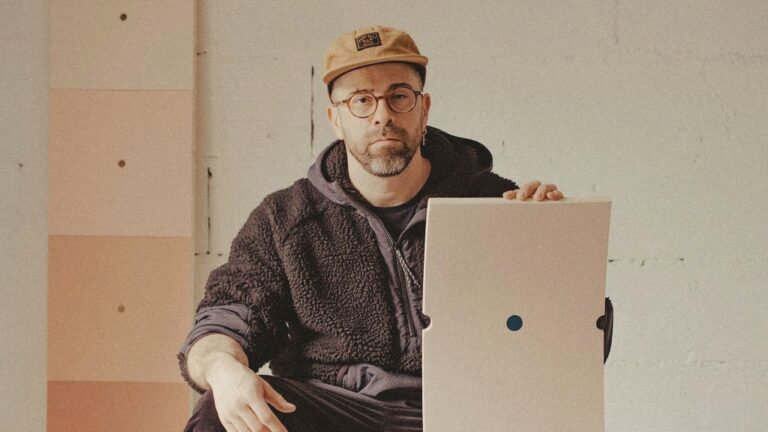
A Conversation with Alejandro Javaloyas
A Studio Visit During the La BIBI Residency
Teodora Axente, (born in 1984 in Subiu, Romania, living and working in Cluj-Napoca, Romania) is a contemporary artist lauded for her paintings filled with mystery, skill, and interesting juxtapositions. Marked by a distinctive figurative language, Axente depicts her subjects in a surreal setting creating a world of her own, having one foot in the tangible or the material world and the other foot in the spiritual or the elusive. Axente has achieved international recognition for her unique oeuvre resulting in solo and group exhibitions at renowned institutions. As a result, the highly rated Romanian artist is seen as one of the most exciting painters from the thriving contemporary art scene in Cluj, Romania.
JD
Teodora Axente, what a pleasure to have you on CAI for an interview. How have you been, and what have you been up to lately ‘painting-wise’?
TA
The pleasure is on my side. I am very glad to be in touch for this interview. My work pace was about the same, or maybe even a bit more intense, during this period. I had the opportunity to spend more time with myself, my thoughts, and my paintings. In general, it was a period in which I sorted, searched, added, deleted, found, gave up, and so on. That is how I would describe ‘creative labor.’
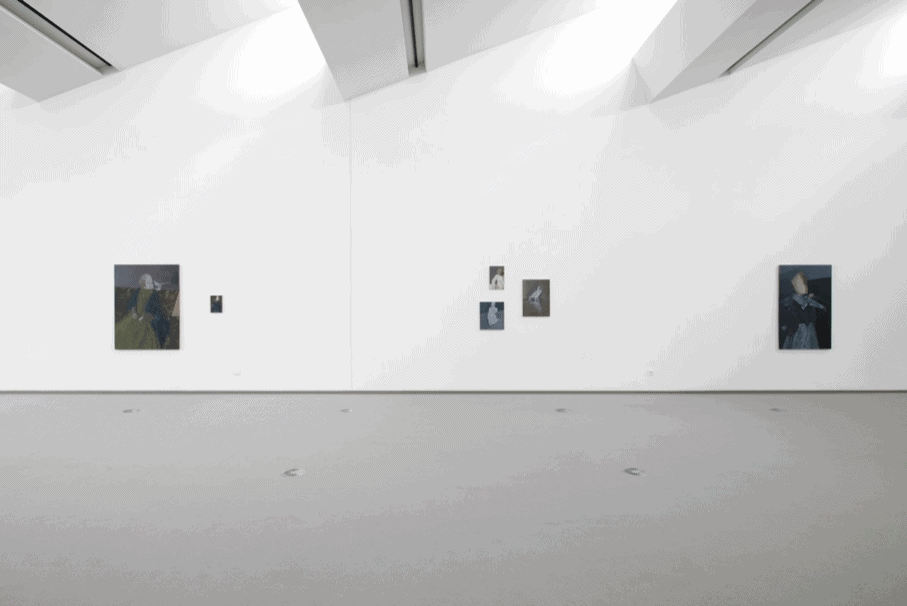
JD
You have studied painting at the University of Arts and Design in Cluj, Romania, where you achieved your MA and a Ph.D. in painting. Do you think you were born to be a painter? When did it occur to you that painting was something you would commit your life to?
TA
That is a good question, and I often wonder why I have chosen painting. Ever since I have known myself, I have enjoyed drawing, painting, and filling the white spaces of sheets of paper, as I drew princesses, landscapes, and flowers everywhere I could. When I was painting or drawing, I felt like I was doing what I knew best, and I was doing it because it came naturally to me. Another childhood game, among many other games, was the pleasure of dressing up in different clothes and objects that I found in my grandparents’ house. I think that children’s fantasy reveals perhaps the best that is hidden in the later adult.
Now, looking with today’s eyes, I find that the experiences of my childhood led me to this path of painting, and the concept of my works reflects fragments of that period. I do not know how much we choose consciously or rather how much we are driven by an inner instinct. But I think that if it is a creative instinct, it must be shaped and then released. As a result, I see myself painting for the rest of my life.
JD
Sadly, there is still the Covid-19 pandemic. How did you experience the covid crisis, and has it affected you as an artist or a person in general?
TA
This crisis has produced an emotional and psychological imbalance in society. For me, it was a period in which I could develop my ideas in the workshop and perhaps sink even deeper into my work. Painting is and always has been my escape from an increasingly crazy world.
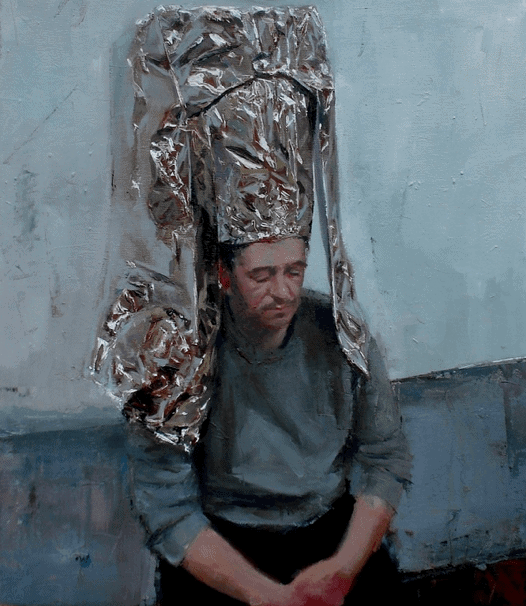
JD
Your work has evolved significantly over the past three to five years. First, could you talk us through your process of creating a painting? How do you select your subjects, the attributes, and how do you direct the image?
TA
The subjects I choose are reflections of my inner states and experiences that I try to give shape in a painting. I have always liked to analyze people in terms of their facial expressions or gestures and, therefore, their outward behavior speaking for their inner state and unseen side. This play of appearances, what is in sight, shining and attracting our attention, and what can not be seen. But intuitions and senses offered me a rich source of images to stage in the form of frames in which my figures evolve. I transpose this palpable world through different textures and materials, objects that surround the human figure and seem to dominate.
I create the costumes of my characters using all kinds of unconventional materials such as foil, transparent foil, paper, etc. I consider these materials the epithets of the mood of my characters. I used to place my characters in a neutral space without too many details and with a focus on the human figure and the strangeness of his or her costume. I admit that I used improvisation and momentary intuition when gathering my props for photoshoots. Later on, I made a series of fashion collages, which opened a new perspective on the way I could set up my projects.
Then I started to select all kinds of image details and put them in collages on the computer like in a puzzle. The collage technique opened a new perspective in expressing my concept. I discovered the possibility of exaggerating certain anatomical details of my human characters, and so I introduced the animal man in the compositions, like the deer woman or the fox woman. My compositions are more crowded now. It seems that after the almost empty neutral spaces that I had created in the past, I have now come to decorate the frames with a multitude of objects and clothing details. When I start to make a collage, I have the impression that I am immersed in a game of chance, but when I finish composing it, I realize that there is harmony and meaning that connects the composition, although this time, my intuition and instinct have guided me. Doing so, the collage offers me an infinite number of working options.
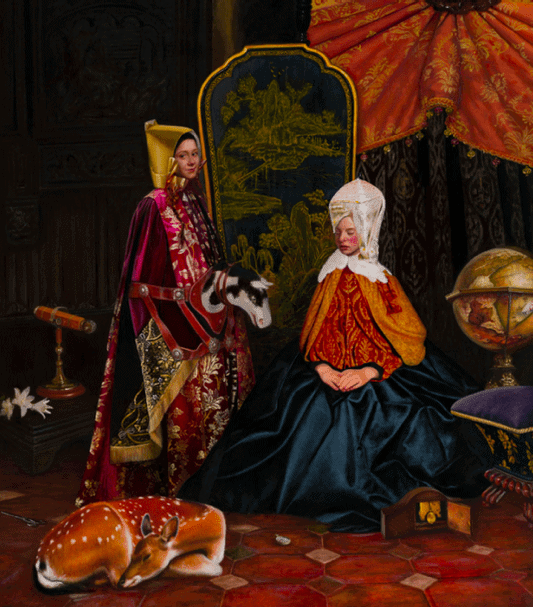
JD
A strong dualism resides in your oeuvre, resulting in an ongoing play of balance with certain binary oppositions. Even the titles of your shows contain this aspect, such as The Noise of Silence or The Absence of Presence. Arguably, the most pertinent dualism is the material versus the spiritual. In what way do you implement this dualism, and with what objective or intention?
TA
That’s right; my message is based on this game of dualism. Matter versus spirit is the main clue I use to shape my ideas. These are the two aspects that I always reflect on, which generate new forms and ideas in my process. Two constants of our life form this balance or unity. Balance is, in my opinion, a basic law of nature in this world. Human beings are created from matter on the one hand and soul or spirit on the other. I was interested to discover this phenomenon and eager to see how I could implement this aspect in my painterly practice. Even with myself as an individual, there is a universe full of contrasts to discover very different states of feeling.
Those dual constructions, such as the Noise of Silence or the Absence of Presence, actually synthesize this aspect of the individual’s need for an interdependent balance and unity. The void and the fullness, the absence and the presence, the outer and the inner, the being versus the non-existent, are the dualities in my work that are meant to outline the portrait of the contemporary man. As a result, my works are reminiscent of the individual’s struggle with himself as a person.
For instance, I refer to the consumer society because I consider that the individual has become a slave of his own vices. And the consumer society is an entity in which we mirror ourselves at this very moment. I draw a parallel between the consumerist side of the individual with the spiritual side. The two poles always create a continuous struggle for the individual. Isolation, anxiety, lack of communication, and weakness are the problems my characters face. The individual needs to reinvent himself, and that is why he relates to the spiritual dimension.
In order to define these two sides of the human being, the material and the spiritual, I chose to wrap my characters in cheap but shiny materials such as foil or cellophane ornaments that evoke the individual’s dependence on the consumer society but also highlight superficiality. For example, the Becoming series evokes precisely that self-denial of the human being. Self-denial is effectuated in a ritual in which my characters are either on their knees or levitating above a chair from which only the legs remain, indicating the self-struggle.
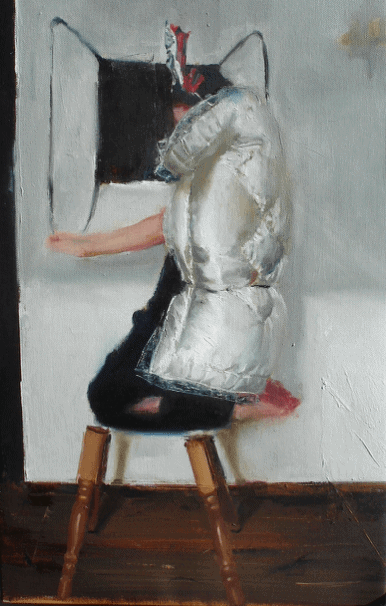
JD
From a painterly point of view, one cannot help but admire certain brushstrokes. In particular, the depiction and reproduction of certain textures of the fabrics you include in your paintings. For instance, aluminum foil, fur, satin, or lace. What do they represent? Should we read those fabrics as metaphors, or are they subordinated to the greater picture?
TA
I present an unexpected series of materials through which I evoke the amalgam of matter that has mastered my characters. They become dependent on the matter that will dominate them, and that seeks to shape them from within. The presence of aluminum foil, plastic bags, satin, velvet, pearls, or furs evokes that state of mystery in some places with noble aspects, which fascinates the eye at first sight, but also becomes contrasting through the strangeness of association of the chosen objects and materials.
Aluminum foil is, for me, the symbol of matter. The brilliance and power of the foil to reflect that in a mirror gives off an illusory feeling of nobility and preciousness. Always at the crossroads between the search for itself by detachment from the temptation of matter and on the other hand, captive in the middle of a world tributary to it, the individual remains captive in the prison, which is the body that is – although adorned – celebrating its grandeur in captivity.
I develop a form of ritual alienation wrapped in various textures and materials on the back of which the characters are isolated and silently waiting for their self-becoming in an inert state and deep silence. This is the terrible schism that has occurred in the condition of the contemporary, new man, converted into a trophy of a ‘self’-image.
The different textures of the materials are the ever-evolving states and dynamics of the inner/soul. The internal dynamic is in permanent relation with the factors, the external receptors. The materialities that I follow in my painting are the metaphors of our senses or feelings. For example, gold is the metaphor for pride; plastic foil alludes to sensitivity and vulnerability; aluminum foil embodies the myth of Narcissus due to its ability to reflect beings, and objects, like the mirror; velvet invokes charm, self-confidence; the pearl reminds of nobility, but also depth, interiority—if we refer to the process by which a pearl is born.
The light that could illuminate the darkness of the mind is only the vain hope of the individual who believes that he can free himself from the burden of matter. Inner knowledge is not acquired by touch, as the hand would recognize matter by touch. My character is in the darkness of reason; he perceives the world only by the delight of gaze and touch. In vain, he puts on golden collars wanting to part with vanity, but it is only a false promise, as is the material from which the collar is made. My characters triumph over a world of chimeras, falsehood, and illusion; only matter is the only thing that ensures and nourishes its glory.
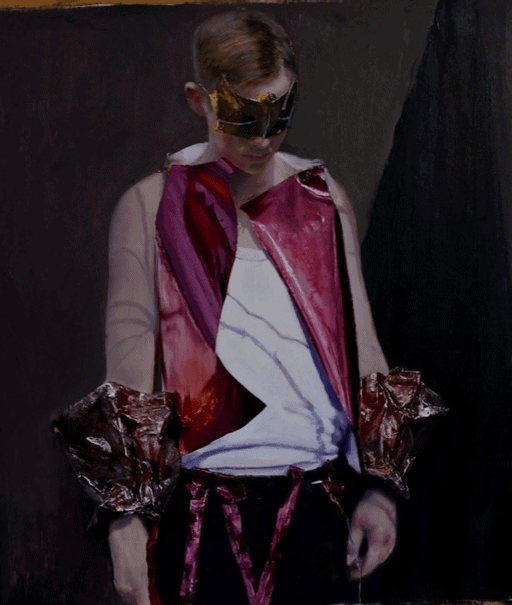
JD
There is a wider tradition connected to the reproduction of fabrics in art history. Think of the Rembrandt impastos or Velazquez’s nervous brushwork virtuously reproducing the qualities of certain clothing. In some ways, you seem to continue—or rather revive—this painterly tradition in contemporary painting. Is this dialogue with art history a premeditated strategy or rather a logical outcome of cause and effect?
TA
It was a challenge for me that I chose to commit to due to the fact that the artists mentioned above were and will always be a source of inspiration for me. It can also be considered a dialogue with art history. I follow a process of deepening a technique in order to expose my concept in the context of today’s society. I find that the traditional painting technique is an inexhaustible source of inspiration; it is the language I am still looking for and analyzing its facets. It’s like trying to translate a text from one language to another; you need a vocabulary of words and tools to operate.
Ernest Schachtel argued that chromatic experience is a parallel to emotional experience, and color and emotion produce effects. It is also said that a painting is perfect when it contains a variety of plastic effects obtained due to the artist’s virtuosity in feeling and manipulating color in various ways. Roger Avermaete said that Rembrandt’s release through art was produced by a certain ‘brutality’ as the result of a grueling search and probing activity.
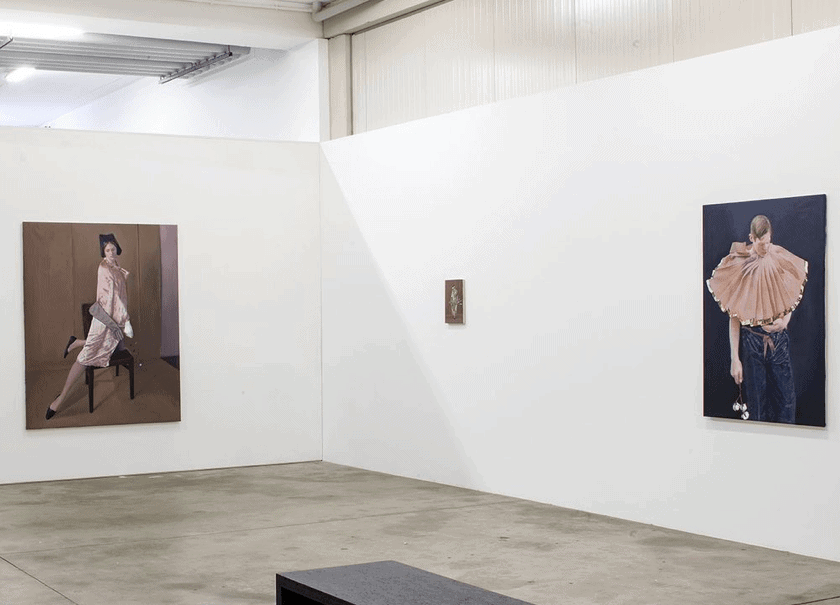
JD
Over the past few years, your imagery has become an almost horror vacui setting. Whereas previously, the space or room in which the subject was depicted felt like a neutral stage, in your recent works, those rooms have become true decors, almost withdrawing our attention from the subject and spreading it over the entire canvas. How did this tendency come about?
TA
Yes, in recent works, it seems that I have changed my focus when it comes to the characters. In fact, they bring more to light scenes from the inner universe of the characters. The different objects that describe the frames seem to be detached from different realities; they contrast with each other by the fact that they are framed in the same set and do not seem to have any common denominator, raising a number of questions.
I’m looking for the clutter of things around the character to no longer have a logical function or to portray their story from the world we really perceive, but to function as so-called ‘ready-made,’ for example, details on the costumes of the characters such as insects, the sleeves of shells, serve as clothing decorations. Details of scientific instruments such as tellurion, clocks, globes, telescopes, wooden boxes, mirrors, scissors, curtains, glasses, dishes, and furniture inserted in landscape backgrounds describe the story of a dreamlike ensemble in which the real makes room for the unreal, the imaginary.
It is a game of escaping from a world of conventions to a world dominated by fantasy, magic, and chance. Time and space no longer exist as they are represented by the props described above, but the meaning has changed. In fact, all these props dress my characters like a coat, surrounding and dominating them, they seem cloistered by these crowded frames, but the outside tells the story inside them.
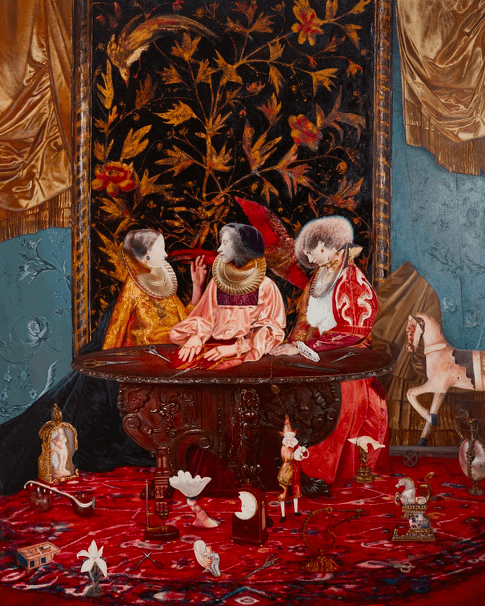
JD
Thank you for the intriguing interview, Teodora. It has been an absolute pleasure. We will continue to keep an eye on you, as always!
TA
For me as well, it was a pleasure to answer your questions and to bring light to some aspects of my work. Thank you!
Last Updated on May 2, 2023

A Studio Visit During the La BIBI Residency
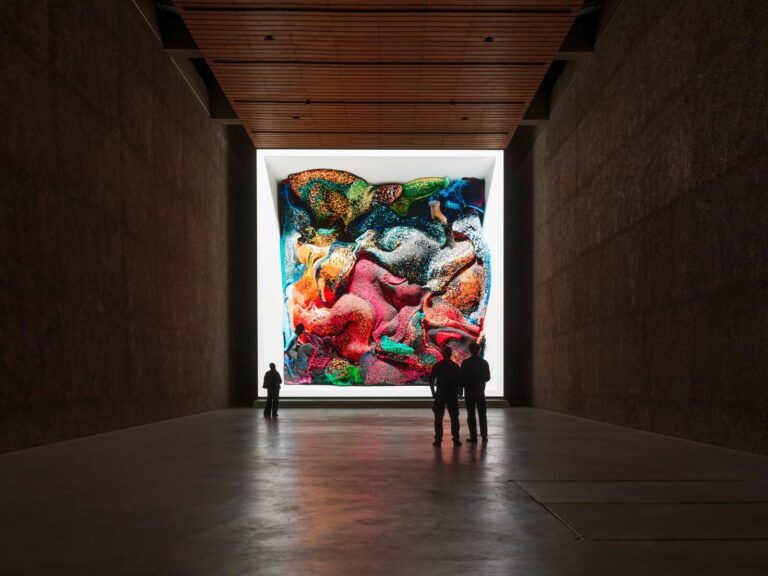
A Reasoned Anthology